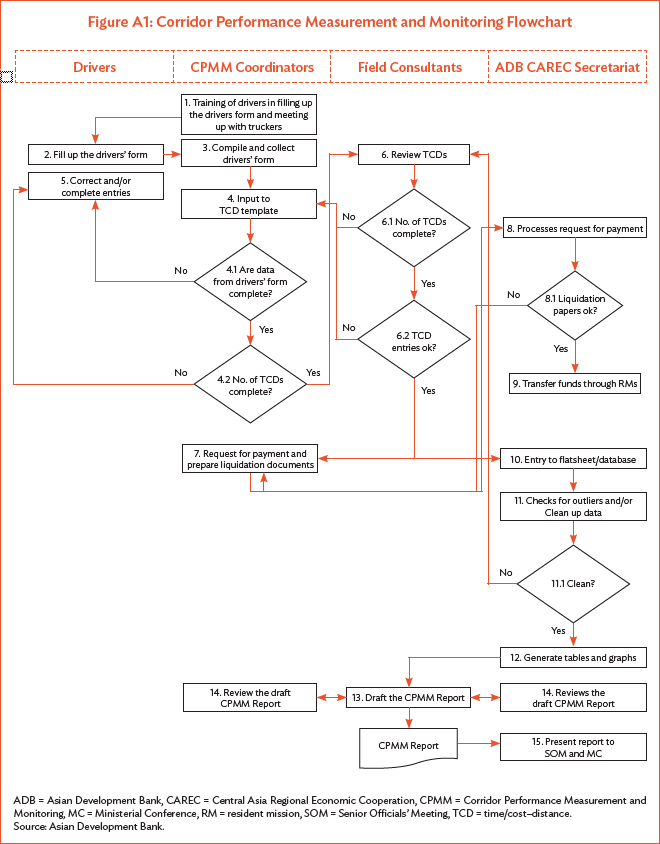The Corridor Performance Measurement and Monitoring (CPMM) methodology is based on a time/ cost–distance (TCD) framework and involves four major stakeholders: (i) drivers, (ii) CPMM partners and coordinators, (iii) field consultants, and (iv) the Central Asia Regional Economic Cooperation (CAREC) Program trade facilitation unit.
The TCD methodology, developed by the United Nations Economic and Social Commission for Asia and the Pacific, focuses on the time and costs involved in transportation and analyzes transport inefficiency and bottlenecks. It lays out the cost and time components of door-to-door movements of a vehicle along a transport corridor, and tracks delays at borders and other inspection points along the corridor.
Under the CAREC CPMM, coordinators of each CPMM partner every month, and randomly select drivers transporting cargoes passing through the six CAREC priority corridors to fill up the drivers’ CPMM forms. The coordinators enter data from the drivers’ forms into TCD spreadsheets. Each partner association completes about 10–30 TCD forms a month, which are submitted to the field consultants and screened for consistency, accuracy, and completeness.
The TCD data submitted by partner associations is normalized so each TCD sheet can be summed up and analyzed at the subcorridor, corridor, and aggregate level of reporting.
Normalization of each TCD sheet comprises the following steps:
The Central Asia Regional Economic Cooperation (CAREC) Corridor Performance Measurement and Monitoring (CPMM) partners are national carrier and forwarder associations already established in CAREC member countries and are essential to the success of the CPMM mechanism. Trained to gather CPMM raw data, their key responsibilities include the following:
- Each TCD is split between the non-BCP portion and BCP portion in case the shipment crossed borders.
- The time and cost figures for the non-BCP portion are normalized to 500 km by multiplying the ratio of 500 km by the actual distance traveled.
- The time and cost figures for the BCP portion are normalized based on the ratio of a predetermined number of BCPs for each 500-km segment over the actual number of BCPs crossed.
- The TCD is reconstituted by combining the normalized non-BCP portion and the normalized BCP portion.
The detailed CPMM flowchart is in Figure A1.

CPMM Partners
CPMM partners are national transport carriers and forwarders selected to work with the CAREC Trade Facilitation Unit in implementing the CPMM. A specific person is assigned by each partner to receive training on the CPMM mechanism, train the drivers, customize the drivers’ form, and enter the data into a customized spreadsheet. ADB pays the CPMM partners based on a predetermined unit rate per survey.
National Association Drivers
To ensure accuracy of CPMM data analysis, raw data should be collected as close to the source as possible. Drivers are asked to record how long (time) or how much (cost) it takes them to move from origin to destination. The drivers use a country-specific driver’s form to record and submit data to the CPMM partners.
CAREC Trade Facilitation Unit
Based in the headquarters of the Asian Development Bank, Manila, the CAREC Trade Facilitation Unit is responsible for collecting and aggregating all completed CPMM spreadsheets. Using specialized statistical software, the team constructs the charts and tables for analysis by the field consultants, and assists in CPMM report preparation.
